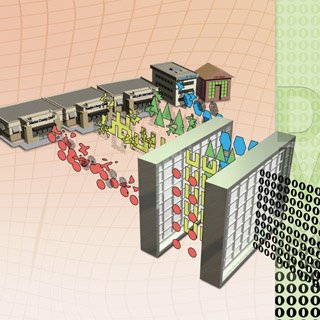Chapter 20. The Dangers of Data Mining
| To live in a modern society is to leave digital traces of yourself with almost every action you take. Buy a meal at a restaurant? You probably paid for it with your credit card. Take out a library book? There's a record of it in a database. Get born? That gets entered into a database as well. Whether you buy a car, visit a bank, make a phone call, or do any of many commonplace tasks, a record of that transaction exists somewhere. Businesses see gold in that data about you and hundreds of millions of other Americans, and the government sees ways it believes it can better protect its citizens. But the information is spread out across countless databases, so no one government agency or business has access to it all. And even if it could get access, how could it possibly make sense of it all, given that the databases are not connected to one another, run on different systems, and are in different formats? Enter data mining. Data mining uses powerful data analysis tools to examine vast amounts of data and then discover unseen or previously unknown patterns and relationships in them. For example, a bank or credit card company may mine years of customer data and look for patterns that tell it which kind of customers are the best risk and which are the worst risk. It can then apply that knowledge to extending credit to good risks and denying it to poor risks. Medical researchers can mine data to try to uncover the relationship between lifestyle choices and diseases. A retailer might mine data to find out which of its sales, offers, coupons, and affinity programs works most effectively. The government, to no one's surprise, uses data mining as well. For example, the Justice Department mines data about crime rates to find out where to best apply its money and help it decide where to make local grants. The Federal Aviation Administration uses data mining to examine plane crash data to help it find airplane defects and causes of crashes, so it can take action to prevent crashes in the future. Since the terror attacks of September 11, 2001, the government has used data mining to try to track terrorists, prevent future attacks, and screen would-be terrorists from getting on airplanes. But data mining has its dark side, as well. It can be used to peer into every aspect of a person's life and create extremely detailed profiles of a person's lifeand practically track his every move. Data mining companies amass massive amounts of information about people, mine that data, and then sell it to the highest bidder. There have been security breeches at these companies, and detailed information about people, including their Social Security numbers, credit records, addresses, and more, has been stolen by criminals who can use it for identity theft. In the hands of the government, people worry that data mining can be even more dangerous. The government already has enormous amounts of power, and combining this with the ability to create personal profiles of citizens is inherently dangerous, they warn. In addition, if a data mining program incorrectly labels a person as a "potential terrorist," that person's life has in essence been ruined. Data mining is increasingly in the news. For example, it was at the center of a political storm when it was revealed that President Bush authorized the National Security Agency (NSA) to listen in on the conversations of possibly millions of Americans without a court warrant. The NSA tried to mine the data in the calls to find potential terrorists, but many warned that the action violated the law, and even the U.S. Constitution. For better and for worse, data mining is here to stay. The issue is whether it can be controlled and put only to proper uses. |
EAN: 2147483647
Pages: 161
